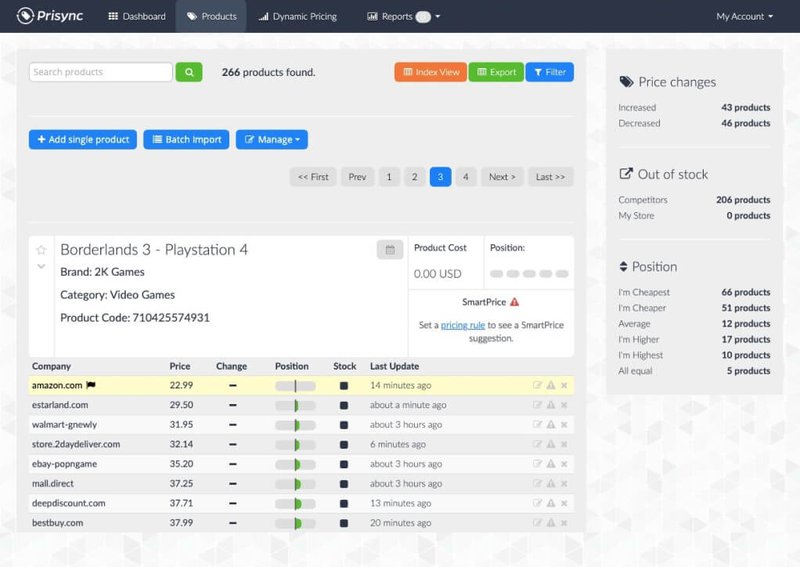An Essential Guide to Competitor Price Tracking for eCommerce Businesses
Learn how to track your competitors pricing, get automatic alerts, and set up dynamic rules to change your price on the weekends and holidays & stay competitive.
Updated November 20, 2023.
It's final. Science has proven that discounts make us happy.
Did you know that a “happy” hormone called Oxytocin is released in our bodies every time we get a coupon? It's scientifically proven that good deals make consumers happier. No wonder that a whopping 88% of American consumers used coupons to shop in 2020.
On the flip side, if you offer a promotion on one channel and not the others, then customers can get pretty upset to find out they paid the full price for a product when it was advertised for less elsewhere. So the challenge becomes to monitor and sync all of your pricing across tens of different marketing channels and online marketplaces (like Amazon and Google Shopping).
That’s why eCommerce marketers should monitor market trends and offer competitive pricing on their entire product assortment.
The problem is that it's impossible to do this manually when you're a medium-large eCommerce company. Here’s where competitor price tracking software can come in handy. In this post, we discuss the benefits of price tracking and provide a rundown of the best price monitoring tools you should use to automate the entire process.
What is competitor price tracking?
Competitor price tracking is the practice of monitoring your competitors on a daily basis to gather insights into their products, prices, promotions, and strategies.
Competitor price monitoring software can help you keep an eye on your competitor’s prices and stock availabilities in real-time and learn how frequently they update their pricing.
This can help you make more accurate decisions about your pricing strategy. These tools may take the form of web apps, mobile apps, or even web extensions.
What are the benefits of tracking your competitors?
Now that we’ve covered what it is, here are some benefits of tracking competitor prices.
1. Accelerate your pricing changes
Consumers love special promotions, sales, and deals. Bigger eCommerce companies and brands exert their influence by changing their prices frequently. If you want to be competitive, you’ll need to respond to these changes quickly.
Now, can you monitor competitors prices manually? Theoretically, yes. But it’s practically impossible (and inefficient) for an eCommerce owner to scan hundreds of eCommerce websites to check competitor prices every day.
With competitor price monitoring tools, data extraction becomes much easier. These web scraping tools will automatically scan competitor websites and trigger price alerts as soon as there is a change. This helps you respond quickly by updating your prices.
According to a study by Price2Spy, by switching to a competitive intelligence tool, you can save up to 92% of your labor costs. Plus, several hours of productive time.
2. Stay competitive on every marketplace
Consumers are always looking for the best deals. And they shop on multiple marketplaces and websites to find them. So marketplaces optimize their prices according to the customer’s demand, occasion, and other factors.
The right tools can help you stay competitive on multiple marketplaces automatically by monitoring competitor prices. This will help you maximize sales and profits and experience meaningful revenue growth.
For example, a special limited-time discount for Cyber Monday can boost sales for retail businesses. Or when your competitors’ stock levels are running low, offer lucrative deals to attract more customers to your store.
3. Outperform your competition on weekends and holidays
Be it Christmas, New Year, Black Friday, or Cyber Monday — eCommerce sales spike during the holidays. And eCommerce brands compete hard to get their share of the pie during these times.
Competitive intelligence tools provide insights into your competitors' product assortments, inventories, and competitive pricing strategies. Most of these tools can help you set up automation rules so that you can change your prices automatically and stay competitive on weekends and holidays — even while you sleep.
4. Gather industry insights to increase your revenue
Pricing tools provide access to enormous amounts of data and insights that give you a competitive advantage. Based on these insights, you can make better-informed decisions.
For example, you may find that your competitor launched a new product. You can get all the information on it (pricing, features, etc.) and consider launching something similar.
You can also get market insights on how competitive the pricing is in your industry and come up with creative strategies to compete less on price and more on the product quality or by offering an amazing customer experience.
You can also use these tools to monitor historical pricing data and uncover changes in customer preferences. Spot these shifts quickly so you can start stocking up on those items that have the highest demand before your competitors even find out about it.
5. Get a better handle on stock availability
Another hidden benefit of using dynamic price software is that you get alerted whenever a popular product of yours is running low on stock. You can set these alerts up with any run-of-the-mill inventory tool, but the added advantage here is that a pricing tool can tell you which low-quantity products are the most important to replenish now.
How price tracking tools can help your eCommerce business
Competitive intelligence tools can help your business in many ways. Here are some of the most common features that they offer:
1. Competitor price monitoring
Competitive price monitoring helps you learn the average price of a product and where your competitors stand so you can adjust your price strategy.
Price tracking tools collect data from thousands of eCommerce brands and marketplaces and present them all on one pricing dashboard, so you could compare your prices to the retail prices of your biggest competitors.
Most of these tools can send you automatic price change alerts whenever your competitors update their product prices. Some can even trigger alerts when a competitor matches your price or beats it.
2. Price intelligence
70% of shoppers say that competitive pricing is what influences them the most when buying from online retailers. So you need to be able to track, monitor, and analyze all of your competitors to make the right strategic pricing decisions.
The best competitive intelligence tools use AI and data mining to analyze how consumers react to price changes and what your competitors are doing to help you determine the ideal pricing for every product.
For example, can tell you which of your competitors have entered into a price war so you can decide not to compete on that product. It can help you understand the strengths and weaknesses of your competitors so you can launch counter-campaigns accordingly.
3. Repricing/Dynamic pricing
Ecommerce businesses often change their pricing — sometimes multiple times a day. Not being able to keep up with competitor prices, especially during holidays and weekends can cost you thousands of dollars in sales.
With features like repricing in your competitor monitoring tools, you can automatically respond to these changes. It lets you set rule-based prices.
For instance, you could set rules such as:
- My product price should be = the lowest price in the market + $5
- My product price should be = the average market price * 1.125
Well-planned pricing rules allow you to be competitive without thinning your profit margins.
But being competitive does not always mean racing to the bottom. Many consumers associate absurdly low price tags with low quality. So how do you pick the right rules in tricky situations or during a sudden drastic change in demand?
This is where dynamic pricing comes in. The right tools use AI to analyze thousands of data points and modify pricing rules in real-time based on the situation.
4. Catalog intelligence and product monitoring
As a growth-minded entrepreneur, you want to have an idea of competitors’ inventory. This can help you identify profitable products or even maintain a decent stock during a sale when others are out.
Features like catalog intelligence make your life easier by allowing you to analyze the complete catalogs of your competitors. You can also get access to any structured information available on competitor eCommerce sites.
Prices, stock, descriptions, barcodes, MPNs, SKUs — just name it and you will find it on your dashboard, so you can determine the best pricing strategy for each product.
5. Price history and eCommerce pricing reports
With a price history report, you can get insights into how often your competitors update their pricing and by how much. You can also see how their prices fluctuate on different occasions and compare historical trends from the last few years.
Obviously, checking for price changes every hour is both impractical and unproductive. With eCommerce pricing reports, you can automatically get all your alerts delivered straight to your inbox.
The best competitor price tracking software
Now that we’ve covered the basic features available on most price tracking tools, here are some of the best ones you can choose from.
1. Prisync
Prisync offers one of the most well-known price tracking and monitoring solutions on the market. With features that allow you to track prices from an unlimited number of competitors, it’s great for analyzing price history, setting repricing/dynamic pricing rules, and tracking competitor stock availability.
It also offers robust reporting mechanisms with instant and daily price change notifications delivered straight to your inbox.
Cost: starts at $59/month, 14-day free trial + Shopify app.
2. Competera
Competera shines when it comes to delivering reliable pricing comparison data and allowing users to make changes in their pricing real fast. It uses Deep Learning algorithms to help eCommerce retailers set the most optimal prices for their products based on demand and a number of other market factors.
It also includes features such as rule-based repricing and cause-effect analysis of price changes.
Cost: custom
3. Minderest
Minderest offers a suite of leading price monitoring tools that helps eCommerce brands optimize their product assortment and pricing strategy. It offers features like price intelligence, competitor price monitoring, catalog intelligence, repricing, dynamic pricing, and eCommerce product monitoring.
It also sends automatic alerts every time there is a change in competitor pricing or inventory.
Cost: custom
4. Skuuudle
Skuuudle is a cloud-based automated price tracking software that helps eCommerce businesses optimize their pricing strategy, set dynamic pricing rules, monitor their competitors’ inventory, and much more.
The sheer amount of data it presents is quite remarkable. The data is accurate and timely too, thanks to their AI-supported quality team.
Cost: starts at $399/month.
5. Price2Spy
Price2Spy is another price monitoring tool that definitely deserves a mention. Apart from offering accurate pricing intelligence and repricing features, it helps you make better strategic decisions and protect your brand value. It also offers a lot of flexibility in its reporting, so you can create custom reports based on your needs.
Cost: starts at $23.95/month, 30-days free trial.
6. Omnia Dynamic Pricing
Omnia Dynamic Pricing is an all-in-one solution for automated price monitoring, data collection, and tracking pricing changes. It allows eCommerce businesses to automate their pricing strategies and create flexible repricing rules that take the pricing elasticity of every product into account.
It also provides valuable pricing insights that you can easily narrow down by your desired product range.
Cost: custom + free trial.
Recap
Competitor price tracking tools can give you invaluable insights into your competitors’ pricing and overall business strategies. Investing in a robust competitive intelligence tool is definitely worth it.
Just make sure the price tracking tool you choose fits your business needs and is robust enough to track all of your major competitors, on every channel and marketplace. Use pricing tools to generate more sales, grow your business, increase your market share, stay competitive, and improve your brand positioning.















